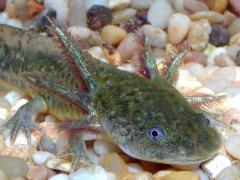Eastern Tiger Salamander
The Eastern Tiger Salamander is the largest salamander in New Jersey, reaching up to 13 inches in length. The eastern population is disjunct and declining due to habitat loss and fragmentation, development, pollution, illegal collecting, changes in hydrology, and climate change.
 Zoom+ Eastern Tiger Salamander (c) Dave Golden
Zoom+ Eastern Tiger Salamander (c) Dave Golden
Eastern tiger salamanders, Ambystoma tigrinum tigrinum, are the largest salamander in New Jersey, reaching up to 13 inches in length. Tiger salamanders are dull brown with irregular yellowish blotches and a yellow underside; they have a short snout, thick legs, long tail, and large lidded eyes. Like other Ambystomid,or mole salamanders, tiger salamanders are fossorial, spending much of their lives underground.
In New Jersey, tiger salamanders live in upland forests of the coastal plain in underground burrows feeding on worms, snails, and insects. In December, they emerge on rainy nights and migrate to vernal pools to breed, depositing egg masses of 30-70 eggs on submerged vegetation. By March adults have finished breeding and will return to their upland burrows. Eggs hatch in approximately 30 days, and larvae remain in pool feeding on zooplankton and invertebrates before metamorphosing in June or July. These new sub-adults will migrate to nearby forests where they will live underground for 4-5 years until reaching sexual maturity and beginning their yearly migration to breed.
 Zoom+ Eastern tiger salamander larvae. © John Bunnell
Zoom+ Eastern tiger salamander larvae. © John Bunnell
Eastern tiger salamanders are the most widely distributed salamander in North America; however the eastern population is disjunct and declining. Historically tiger salamanders ranged from southern New York to northern Florida but the species is now state-endangered in New York, New Jersey, Delaware, Maryland, Virginia, and is extirpated in Pennsylvania. In New Jersey and throughout the eastern range, tiger salamanders are declining due to habitat loss, development, fragmentation of upland and breeding habitat, changes in hydrology, pollution, collecting (pet trade), and climate change.
Ambystomids, like the eastern tiger salamander, are vernal pool obligate species—they require vernal pools to breed. Vernal pools are isolated, ephemeral wetlands with a seasonal hydrology that naturally varies from year to year depending on evaporation, water vapor transport, precipitation and physical attributes such as proximity to other wetlands, size, surrounding vegetation, and access to groundwater1. Due to these characteristics, vernal pools are highly susceptible to climate change as local weather conditions become more variable, so will the hydroperiod of these pools, which affects species composition, productivity, and long-term viability of these ecosystems.
In New Jersey eastern tiger salamanders are limited to 15 known breeding pools with uncertain long-term viability.
In the New Jersey, precipitation is expected to increase overall, but the pattern of rainfall will lead to longer drying events causing premature water loss in vernal pools. These longer drying periods will cause drying of smaller pools, isolating larger pools, and diminishing of metapopulations dynamics1. The potential consequences of these shorter hydroperiods will be significant reproductive failures in vernal pool breeding amphibians as larvae are unable to metamorphose before the pool dries2.
In New Jersey eastern tiger salamanders are limited to 15 known breeding pools with uncertain long-term viability. The majority of these pools are single pond complexes. If the pool becomes degraded, lost to development, or simply dries, the salamanders will be unable to breed that year. These sites are also divided by roads and development, which makes yearly migration uncertain and the possibility of finding a new breeding pool or interbreeding with other tiger salamander populations unlikely.
 Zoom+ Eastern Tiger Salamanders are vernal pool obligate species - they require these temporary pools to breed. (c) Karena DiLeo
Zoom+ Eastern Tiger Salamanders are vernal pool obligate species - they require these temporary pools to breed. (c) Karena DiLeo
Thirteen of these remaining pools are located along the Cape May Peninsula and half are below two meters above sea-level, increasing their risk of salt-water intrusion or inundation from storm surge. Conserve Wildlife Foundation and the New Jersey Division of Fish and Wildlife are mitigating for these potential pool losses by constructing new vernal pools along the Cape May Peninsula that are greater than 3 meters above sea-level. These new pools will restore connectivity between existing breeding sites and aid in migration of tiger salamanders north along the Peninsula. This work is funded by the NJ Division of Fish and Wildlife and a Climate Adaptation Grant from The Wildlife Conservation Society.
1. Brooks RT. 2004. Wetlands 24(1):104-114
2. Brooks RT. 2009. Climactic Change 95: 469-483
by Karena DiLeo






